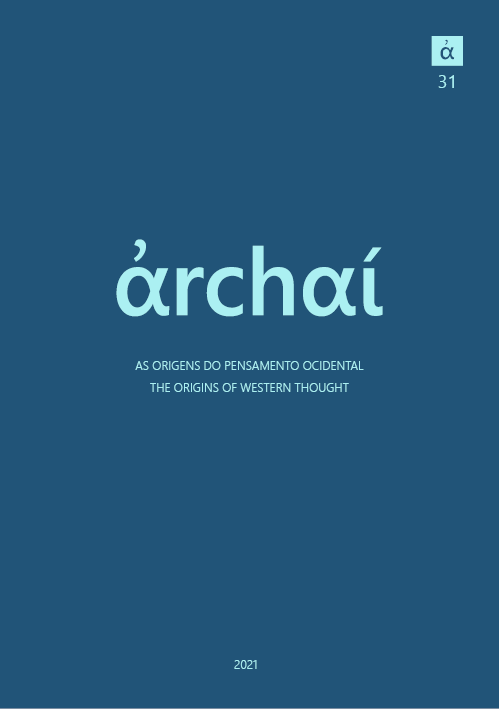Sound-Oriented Textuality: The Case of Heraclitus
DOI:
https://doi.org/10.14195/1984-249X_31_15Keywords:
Heráclito, som, filologia, movimento oscilatórioAbstract
This paper presents the proposal to understand the remaining texts of Heraclitus' lost book as words arrangement based on audiofocal patterns. Thus, such texts would not only contain references to sounds but would also creatively explore psychoacoustic magnitudes. Basic to the argument developed here is the identification of an oscillatory movement present both in the distribution of words and sentences and in textual references. Such oscillatory movement approximates Heraclitus' writing to acoustic physical events.
Downloads
References
BACHELARD, G. (1948). La terre et les rêveries du repos. Paris, Corti.
BOLLACK, J. and WISMANN, H. (1972). Héraclite ou la séparation, Paris, Les Éditions de Minuit.
CASSIN, B. (org.). (2004). Vocabulaire européen des philosophies - Dictionnaire des intraduisibles. Paris, Seuil/ Le Robert.
CASSIN, B. (org.). (2014). Dictionary of Untranslatables. Princeton, Princeton University Press.
CHANTRAINE, P. (1968). Dictionnaire Étymologique de la langue grecque : histoire des mots. Paris, Klincksieck.
CONCHE, M. (1998). Héraclite: Fragments, 4th ed. Paris, Presses Universitaires de France.
DEICHGRÄBER, K. (1963). Rhythmische Elemente im Logos des Heraklit. Wiesbaden, Verlag der Akademie der Wissenschaftten und der Literatur.
DELATTE, A. (1955) Le Cycéon, breuvage rituel des mystères d'Éleusis. Paris, Belles Lettres.
ETTE, O. (2008). Nanophilology. Literary short forms in Romance languages. Literarische Kurz- und Kürzestformen in der Romania. Tübingen, Max Niemeyer Verlag.
GEMELLI, L. (2007). Die Vorsokratiker. Band 1: Thales, Anaximander, Anaximenes, Pythagoras und die Pythagoreer, Xenophanes, Heraklit. Düsseldorf, Artemis & Winkler.
GRAFF, R. (2005). Prose versus Poetry in Early Greek Theories of Style. Rhetorica: A Journal of the History of Rhetoric, Vol. 23.4, p. 303-335.
GRAHAM, D. (2010). The Texts of Early Greek Philosophy: The Complete Fragments and Selected Testimonies of the Major Presocratics. Cambridge, Cambridge University Press.
HOFFMAN, D. (2003). Logos as Composition. Rhetoric Society Quarterly 33, p. 27-47.
HOFFMAN, D. (2006). Structural Logos in Heraclitus and the Sophists. Advances in the History of Rhetoric, Vol. 9, p.1-32.
JAKOBSON, R. (1999). Linguística e poética. In: Linguística e Comunicação. São Paulo, Cultrix, p.118-162.
JOHNSTONE, H. (1984). Heraclitus’ [Peri Physeos]. Bryn Mawr, Bryn Mawr College Department of Greek.
KAHN, C. (1979). The Art and Thought of Heraclitus. Cambridge, Cambridge University Press.
KAHN, C. (1983). Philosophy and Written Word: Some Thoughts on Heraclitus and The Early Greek Uses of Prose. In: ROBB, K. (ed.). Language and Thought in Early Greek Philosophy. La Salle, Monist Library of Philosophy, p. 110-124.
KAHN, C. (2003). Writing Philosophy: Prose and Poetry from Thales to Plato. In: YUNIS, H. (ed.) Written Texts and the Rise of Literate Culture in Ancient Greece. Cambridge, Cambridge University Press, p.139–161.
LAKS, A. and MOST, G. (2016). Early Greek Philosophy, vol. 3. Cambridge, Harvard University Press.
LEBEDEV, A. (2014). The Logos of Heraclitus: A Reconstruction of His Thought and Word (with a new critical edition of the fragments). São Petersburgo, s/ed.
LILIJA, S. (1968). On the Style of the Earliest Greek Prose. Helsinki, Societas Scientiarum Fennica.
MARCOVICH, M. (1967). Heraclitus. Mérida, University of the Andes Press.
MONBRUM, P. (2007). Les Voix d’Apollon. L’arc, la lyre et les oracles. Rennes, Presses Universitaires de Rennes.
MOTA, M. (2014). Imaginação e Morte. Ensaios sobre a representação da finitude. Brasília, Editora da Universidade de Brasília.
MOTA, M. (2018). Metafisica, Escrita e Música: Ensaios Sobre os Fragmentos de Heráclito. Lisboa, Movimento Internacional Lusófono.
MOTA, M. (2020). Audiocenas: Interface entre Cultura Clássica, Dramaturgia e Sonoridades. Brasília, Editora Universidade de Brasília.
MOURAVIEV, S. (2002). Heraclitea III.3.A. Sankt Augustin, Academia Verlag.
PRADEAU, J.-F. Heráclite. (2004). Fragments. Paris, Flammarion. ROBINSON, T. M. (1987) Heraclitus. Toronto, University of
Toronto Press.
SLUITER, I. (2016). Obscurity. In: GRAFTON, A. and MOST, Glenn (eds.). Canonical Texts and Scholarly Practices. A Global Comparative Approach. Cambridge, Cambridge University Press, p.34-51.
VATRI, A. (2019). Early Dactylic Prose in the History of Greek Prose Rhythm. In: PASSA, E. and TRIBULATO, O. (eds.). The Paths of Greek. Literature, Linguistics and Epigraphy. Berlin, De Gruyter, p.175-196.
WEST, M. (2007). Indo-European Poetry and Myth. Oxford, Oxford University Press.
Downloads
Published
How to Cite
Issue
Section
License
Copyright (c) 2021 Marcus Mota

This work is licensed under a Creative Commons Attribution 4.0 International License.
Given the public access policy of the journal, the use of the published texts is free, with the obligation of recognizing the original authorship and the first publication in this journal. The authors of the published contributions are entirely and exclusively responsible for their contents.
1. The authors authorize the publication of the article in this journal.
2. The authors guarantee that the contribution is original, and take full responsibility for its content in case of impugnation by third parties.
3. The authors guarantee that the contribution is not under evaluation in another journal.
4. The authors keep the copyright and convey to the journal the right of first publication, the work being licensed under a Creative Commons Attribution License-BY.
5. The authors are allowed and stimulated to publicize and distribute their work on-line after the publication in the journal.
6. The authors of the approved works authorize the journal to distribute their content, after publication, for reproduction in content indexes, virtual libraries and similars.
7. The editors reserve the right to make adjustments to the text and to adequate the article to the editorial rules of the journal.



